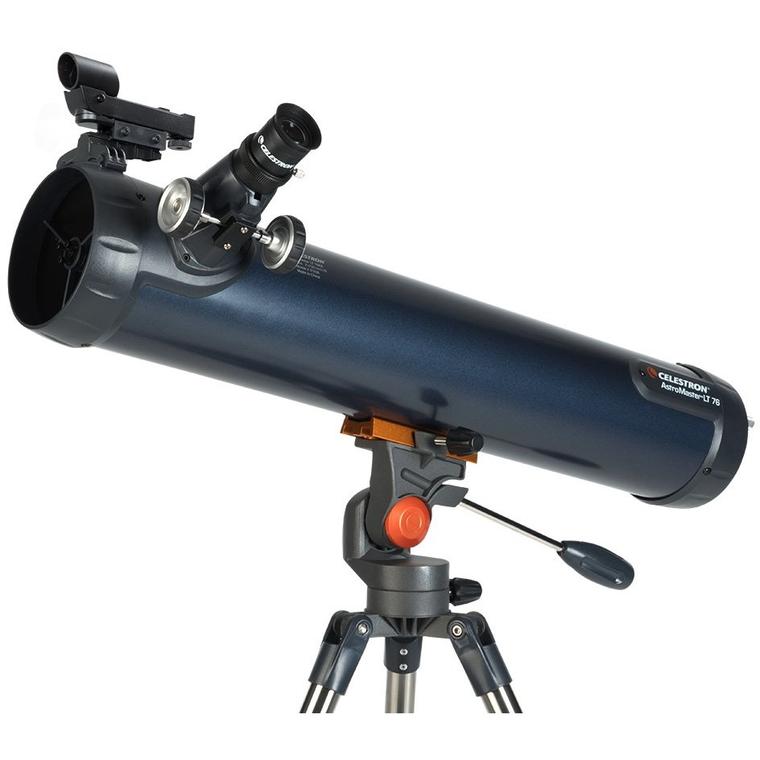*This post may contain affiliate links. This means we may make a commission if you purchase an item using one of our links*
Welcome to my Celestron 31036 AstroMaster LT 76AZ Review!
In this review I’ll cover the pros, cons and the 76AZ’s features to ultimately help you decide on whether the system is worth investing in or a beginner level device that you should skip out on.
Overview
Table of Contents
- Full Name: Celestron 31036 AstroMaster LT 76AZ
- Type: Newtonian Reflector
- Aperture: 76mm (3″)
- Focal length: 700m
- Focal ratio: f/9.27
- Weight & Height: around 7kg with the height being between 0.81m – 1.3m
- Included eyepieces: 2 1.25″ kellner eyepieces at 20mm and 10mm
- Rating: 2/5
Pros
- Easy to assemble
- Lightweight
- Affordable
- Good accessories for the price
Cons
- Limited performance
- Better options out there for a bit more
- The max height is a little small
- Will require regular maintenance
- Flipped image through the finderscope (upside)
- Quick and easy no-tool setup
- Permanently mounted StarPointer finderscope
- Quick release dovetail attachment - no tool setup
- Pan handle Alt-Az control with clutch for smooth and acurate pointing
- Rugged pre-assembled tripod with steel tube legs provides a rigid and stable platform
How Do The Celestron AstroMaster 76AZ’s Optics Work?
The 76AZ uses Newtonian reflector optics within the tube which in theory means that it utilises a parabolic mirror inside however, taking into account the costs of the device, there’s a very good chance that the mirror inside could be spherical or even a birds and jones variant (which would make it tough to align the mirrors)
No matter the case, assuming the mirrors are Newtonian reflectors they will have their benefits, particularly over the other 2 optical variants in refractor optics and compound optics (A hybrid of both the reflector and refractor optics).
The pros of the optics within the 76AZ are as such :
- The optics are great for viewings faint objects in the sky as all types of light can pass through the lenses (this isn’t the case for a refractor telescope).
- Reflectors are generally cheaper to manufacture, resulting in cheaper telescopes.
- These optics don’t suffer from chromatic aberration unlike refractors
As for the cons, they are the following :
- The optics are exposed meaning you’d need to clean them up regularly
- You’ll regularly need to collimate the device too as they’re easy to knock out of alignment
- Low focal ratio reflector devices tend to suffer a lot more from comatic aberration
- Could suffer from spherical aberration if the mirror is spherical
- Can’t view things on earth very well unlike the other 2 variations
- They can’t double spotting scopes unlike the other 2 variants
The optics within the 76AZ are more than likely going to be subpar for most users, especially when you take into account the under $100 and mediocre specs and accessories that come with it as a result.
Then again you’d be hard pressed to find solid optics within this price range anyways.
What Do The Celestron AstroMaster 76AZ’s Specifications Mean?
For the price you’ll be paying for the 76Az you shouldn’t expect great specs at all nevertheless, the 76AZ has an aperture of 76mm (3″), a focal length of 700mm resulting in a focal ratio of f/9.27. The larger focal ratio does mean that any spherical aberration and even coma will be reduced with narrower views being its stronger quality.
The aperture also means that the 76AZ should be able to display a theoretical max magnification of 152x although in reality the true usable value will be around 100 – 120x mark.
With that being said you should still be able to see a decent amount of things once the system is collimated and if you’re able to achieve the 76AZ’s max power.
The objects you should be able to see included the following :
- The moon and its craters in reasonable detail
- Jupiter in reasonable detail
- Saturn and an outline of its rings near max power
- Mars, Mercury and Venus should be visible although not in much detail
- You should be able to make out some star clusters, a few galaxies as bright dots and maybe some asteroids if you’re able to track them and if they’re near enough to you.
As the tube is so small it shouldn’t be very surprising that the 76AZ will be quite portable out of the box too. The device should come in at around 6 – 7kg with the tripod weighing in at 3.45kg. The tripod is also quite limited in how high it can go with it ranging between 0.81m – 1.3m making it most comfortable for children more so than adults or taller individuals.
Accessories Included In The Box
The 76AZ comes with 2 1.25″ kellner eyepieces at focal lengths at 20mm and 10mm, a built-on starpointer red dot finderscope, a tripod, a Manual Alt Azimuth mount and a bunch of other documents.
The accessories aren’t really all that bad considering the price but, they can all certainly be improved if you want the maximum performance out of the 76AZ, particularly the eyepieces.
What Are Users Of The Celestron AstroMaster 76AZ Saying?
The device for the most part is considered a beginner level device and when users have gone in with that mindset, it doesn’t seem to be all that bad for most. Although one major issue it does have is that the images upside down (flipped).



Nevertheless, I don’t really think it’s worth buying especially when there are so many better options out there if you’re willing to spend a bit more.
Other Alternatives Worth Checking Out
If you’re interested in some of our best choices for telescopes under $300, check out this list of ours.
If on the other hand you’re more so interested in great alternatives within the $100 range specifically the Zhumell 100 or 114 are great options or the meade Lightbridge Mini 114 is a solid option too.
Summary
Overall The Celestron AstroMaster 76AZ is a very mediocre device but, that is to be expected considering the price. If you’re satisfied with seeing the moon in solid detail and catching somewhat blurry glimpses of the planets uptil Saturn, it may be worth it but, if you or your kin is serious about this hobby, I’d suggest getting a 114mm telescope at the very least.
That’s why I personally wouldn’t suggest you actually buy the 76AZ as it just isn’t all that great as a beginner level telescope. Nevertheless, if you’re sold on it I won’t stop you.


